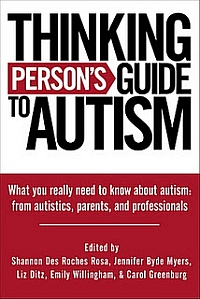Forget False Dichotomies: The Bell Curve of the Autism Community
 Diane Yapko writes an interesting piece at PsychCentral on neurodiversity, noting that the stark contrasts that many would place, neurodiversity versus cure, on the autism community, really don’t exist. Perhaps it’s inevitable that the debate gets rendered in black and white so that neurodiversity is presented as an ideology that would leave autistics without treatment, without therapies, the them in this us-them tug-of-war.
Diane Yapko writes an interesting piece at PsychCentral on neurodiversity, noting that the stark contrasts that many would place, neurodiversity versus cure, on the autism community, really don’t exist. Perhaps it’s inevitable that the debate gets rendered in black and white so that neurodiversity is presented as an ideology that would leave autistics without treatment, without therapies, the them in this us-them tug-of-war.
Perhaps there are people who are that two dimensional; perhaps there is a group of people who claim to be neurodiverse and think that means no treatments, no interventions, no help for a child. I hate the thought that there are people out there who would literally do nothing to help their child to grow, to develop, to overcome obstacles, who wouldn’t move heaven and earth to help their child. Of course, we know there are parents out there like that in the general community, parents who fail their children in every conceivable way, and that undoubtedly happens for autistic children as well. On the flip side, there are no doubt parents, who in their zeal to cure their child, go too far, and in the process of running down every possible cure, subject their children to nearly equally abusive experiences. And maybe both sets of parents conceivably do all these things and more in the name of love.
I heard someone say, in a recent interview I was listening to, that it’s out of love parents do things and who are we to judge. But we do, each and everyone of us judge. Even this person. We can’t get around that. We hold up other people’s behaviors to our owns, we compare, and we place our decisions as the right ones. If other parents deviate beyond the threshold of what we’d be willing to do or believe to be morally plausible, then they are wrong, they’re bad parents. We all do it, and we do it with pride in our decisions, in conviction of the superiority of our positions, convinced we’ve displayed clear critical thinking skills and that anyone who disagrees has failed to exercise those skills.
I tell my students, sometimes daily, that we are always assured that if we believe it, we are right, and “if I’m right and you believe differently, you have to be WRONG.” A lot of the rhetoric on autism talks about how two dimensional autistic individuals are, how hard a time they have of seeing shades of gray. The reality is that we are all hardwired for black and white. All of us. It’s only when we begin to shift our own personal actions into what we’d have considered no-no areas that there become shades of gray. Grays only become visible when we mentally place ourselves in other people’s situations and try to get a sense of what we’d do faced with the same situation, when we really think about what we’d do and start chasing down possible consequences.
Children see the world starkly: right or or wrong, heroes and villains. Our cartoons and comics often reinforce this flatness: Batman is a moral arbiter; while attracted to Catwoman, he rejects her because she operates outside the law, even though her aims might be laudable; he ignores that his actions arise from the same moral stance (been re-watching animated batman with the kids, offers lots of opportunity to discuss morality and theory of mind issues). Our fiction also renders things flatly, especially the popular fiction. Most of us, despite our tendency to think starkly (us-them dichotomies), find ways to navigate the world more multi-dimensionally. We ignore those differences we’ve decided don’t matter in our real world relationships and only attend to those belief systems that are fundamental to our core identities. Not into politics? Then you probably don’t care if someone is republican or democratic. Not into religion? Then you don’t care overly much whether someone believes. We do this for countless potential differences.
If we have one core dimension that we consider foundational to our identity and we find others who have that commonality, we focus on core commonalities and ignore the differences, dismissing the importance of those characteristics. This happens in our autism community as well, but instead of focusing on the overarching commonality of autism, what we do, some of us, is focus on differences, real or imagined, to create a clear us-them dichotomy. We do this, even if it means we create huge strawman arguments to create the other side so that we have a clear group identity.
That means some of us set ourselves up as the aggrieved ones who are woefully misunderstood and persecuted. Some of us set ourselves up as martyr parents. Despite the desire to believe there are clear us-them divisions, there aren’t, and if one takes the time to read through the lines of some of the more strident postings out there, it should become evident that we are often more in agreement than not. I think most of us, though, reject that hardcore us-them mentality. I see it daily on the blogs on our directory. Some are fringe bloggers, but most just want to talk about their lives, the good and the bad, and get support while giving it.
Let’s assume that there are fringe elements that would either do every conceivable woo treatment out there as well as some who would do absolutely nothing at all, not even basic parenting skills, to help their children. But let’s also admit that we’d be hard-pressed to find actual concrete examples of either true fringe as they are often argued to exist. We’ll place a bell curve on the autism community, if you please.
Oh look, more of us have to be in the middle, with more in common than not. Go figure.
I choose to not define myself as part of the fringes; I would not do absolutely anything, but I would never do nothing. I do not believe that believing in neurodiversity means what some insist it does, but let us say it does: that it is a do nothing philosophy that would not help individuals overcome any challenges or learn anything (rather absurd). Let us say it is the right side of the curve. Let us say the curebies are on the left and they would do a complete reboot if that’s what it took. These fringe elements, these outliers, are not the driving force, either perspective, of the autism community. They’re loud, certainly, but that’s only if you’re fixated on the edges. I’d bet you most people in the autism community are not.
Most of us agree:
We want our children to be accepted into mainstream society as individuals who have innate value regardless of functional levels.
We want research into therapies that will mitigate the symptoms and behaviors that cause them disability, pain, and difficulty.
We want access to effective therapies to help our children overcome their challenges.
We want safe places for our children to be cared for when therapies and treatments do not remove all disabilities and impairments.
We want meaningful work for our children when they grow into adulthood, so that they can feel they are of service and make meaningful contributions to society.
We want support services, education and training for family members and professionals working with our children so that we can best serve our children.
We want acceptance for our families as we work to navigate this world and do the best we can for our children.
We are members of the autism community and encompass family members, individuals on the spectrum, and professionals who provide services to autistic individuals and their families.
We can forget about false dichotomies that do not exist in reality.
We can embrace pluralities of opinions and acknowledge that we are one group, united under a bell curve.
We can work to create the world we wish for our children and ourselves.
Even better, each and every day, most of us do just that.
KWombles blogs at Countering …, as well as at the ever-expanding Autism Blogs Directory. Forget False Dichotomies: The Bell Curve of the Autism Community appears here with her permission.
[image via flickr]
KWombles on 11/19/10 in featured, Politics | 1 Comment | Read More
Comments (1)


I’m not sure whether dichotomies are hard-wired into us, or whether they are learned through culture. There are enough dramatic differences between some cultures that I wouldn’t take a natural disposition towards dichotomies for granted.
However, I do agree with the point you make in this post. I support neurodiversity, but my children also get therapy. I want them to be the best people they can be-I just believe that no matter how far they come, they will always be autistic people. And that’s okay with me.